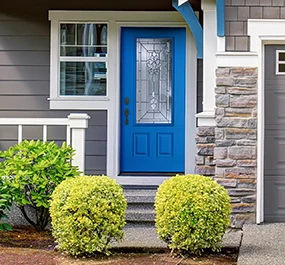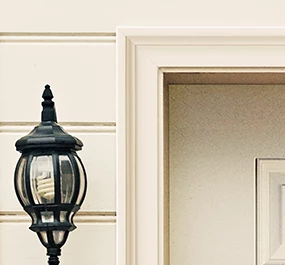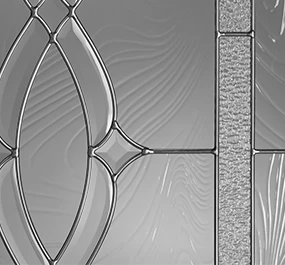Most are well aware of noise-canceling interiors and soundproof walls. But what many don’t consider is that the type of door you choose can also help to block out unwanted sounds and significantly increase quality of life in the home. Since your door is usually the thinnest barrier between your home and the exterior, choosing the right soundproof door that is strong enough to block noise is an important consideration when soundproofing your house. A soundproofed home bars unnecessary noise and keeps your personal space peaceful and distraction-free.
There are many important factors that contribute to how soundproof a door is, including:
- The door type and core material (type and density)
- Proper installation
- The position of the door
- Components used to seal the door
- The presence of glass
- The STC/OITC rating of the door
Plastpro has compiled detailed explanations about soundproof doors, the two testing classes to keep in mind, as well as more information to help you choose the best soundproof doors and find where to buy them.
What type of door material is best for soundproofing?
Wood Doors
When determining the best soundproof door, start with the material of the door itself. High-density materials provide the strongest noise resistance. This means that solid wood doors naturally provide a good option for blocking sound waves because of their density. The level of soundproofing will vary depending on the type of wood, with harder woods generally performing better. However, thick, hardwood doors are typically more expensive than other available options.
Steel and Fiberglass Doors
As opposed to hardwood, steel and fiberglass doors can provide the same level of sound blocking performance and be more cost effective options. Fiberglass and steel doors are also beneficial for soundproofing due to the layered effect of materials. The structure of these door options are foam cores that absorb sound waves encapsulated by a hard surface—fiberglass or steel—that repels sound waves, and the right combination of these materials can provide further soundproofing than an all-wood door.
Core Material
The soundproof rating of these options will primarily depend on the core material used. Look for a high-density, polyurethane foam core, as this will perform better than polystyrene foam, which is less soundproof.
Glass
Keep in mind that the presence of glass will also affect how soundproof a door is. Generally, glass will reduce a door’s ability to block noise, though if you search for a soundproof or laminated glass, you can find options designed to increase the door’s ratings for noise resistance.
Other factors to consider when soundproofing your door
Door Gaps
Even the best soundproof doors can allow noise in through cracks and open spaces. One of the easiest and most affordable ways to further soundproof doors is to reduce any space between the door frame and the door, creating a full barrier. Pay attention to the components that seal the door. For example, a door sill can make a difference on sound ratings, and the type of door jamb material and its fit to the door can also affect soundproofing. For commercial settings, an automatic door sweep is often used to seal the bottom of the door only when it’s closed, preventing noise without creating issues when it drags on the floor. Options for increasing the door’s ability to block sound include sealing any gaps between the door, the door frame, and the wall, perhaps with a special foam or putty and weatherstripping.
Weatherstripping
Weatherstripping is a self-adhesive strip of material that can further insulate your door from both temperature and sound concerns. Check to see if there is previous weatherstripping to remove, ensure that the door fits the jamb securely, and then seal the weatherstripping around the edges. We recommend consulting with a professional about the best materials to use for your situation, and to ensure that the door will still open and close properly.
Door Position
Door position could also make a difference. If you’re incorporating new doors into a home or building, consider where the sound travels. Positioning doors that interact (such as in a hallway) and arranging how they swing can prevent sound from bouncing into adjacent rooms. Additionally, if a door or sidelite is operable and opens, it may have different soundproof ratings than its inoperable, fixed counterpart that serves the interior design over functionality. As you consider these factors, pay attention to local building codes and the difference between residential and commercial requirements in your area. Requirements will be different depending on where a building is located, and in multifamily settings, soundproof requirements can even vary by floor.
Sound Transmission Class and Outdoor/Indoor Transmission Class help classify soundproof door performance
Scientists have devised a soundproof performance system, Sound Transmission Class (STC), to help classify levels of soundproofing in doors, windows, walls, etc. STC ratings cover the majority of common noises we hear—think television, music, human speech and animal noises—and the higher the STC rating, the better the door at blocking out unwanted noise.
The STC is the most common rating used in North America for determining airborne sound transmission loss between 125 and 4,000 Hz. This rating is essentially an average over the 16 frequency points tested. Look for a high STC rating for superior performance.
Meanwhile, the Outdoor/Indoor Transmission Class (OITC) covers a wider range and lower frequency than the STC. The OITC is determined from testing between 80 Hz and 4000 Hz. Notably, road noise is a lower frequency sound, so depending on the proximity to busy streets and interstate highways, it is important to consider the OITC rating and look for higher numbers. A higher OITC demonstrates a door’s increased ability to prevent low-frequency sounds from entering the home.
Fiberglass doors are made as great natural sound insulators
Fiberglass doors have some type of foam at their core, which gives them the opportunity to be extremely well-insulated and one of the best soundproof door options if the foam is high-density.
At Plastpro, our advanced CFC-free, high density, polyurethane foam core enhances the door’s soundproofing capabilities. The composite material on either side of the foam core creates both a weatherproof exterior and a layered effect that further muffles noise. Our doors provide insulation up to six times greater than the typical wood door. View the STC and OITC ratings for our doors on our Sound Proofing Testing Information page.
Check out Plastpro’s Where to Buy page to find the closest distributor for fiberglass interior and exterior doors. For more information on our fiberglass door offerings, visit our website.



